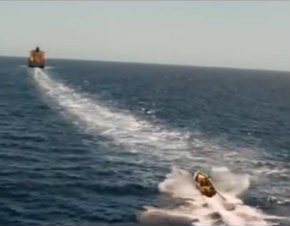The view from above

The philosopher and historian Pierre Hadot wrote that “the view from above” is the “philosophical way par excellence of looking at things.” Seeking a cosmic perspective on human existence, ancient lovers of wisdom cultivated a view from above through spiritual exercises. Distance, they argued, reveals connections, correspondences and patterns that cannot be seen up close. From a bird’s-eye view, as the poet Goethe wrote, we can see “the mad labyrinths of the world spread out before us.”
I was reminded of the ancient desire for an encompassing view of the world while watching Paul Greengrass’s film Captain Phillips. Based on the hijacking of an American container ship by young Somali pirates and their kidnapping of the ship’s captain, the film is marked by frequent shifts of perspective. We move back and forth between the bridge of a massive container ship afloat in the Indian Ocean and the hull of the pirates’ tiny skiff as it is battered by the waves. One moment we are in the captain’s SUV, listening to his worried conversation with his wife about their children’s futures; in the next we are in a camp where Somalis live in inhuman conditions, the monotony of their days broken only by the appearance of armed men who take the young men out to sea to rob passing ships.
Read our latest issue or browse back issues.
By insisting that we regard the events of the film from the perspective of every character, the film reaches for an encompassing view of the world’s “mad labyrinths.” From a distance the defining image of the story is clear: a very small boat gaining on a very large one. We look down on the two boats from the sky; we see them locked in relationship on the ship’s radar screen. We realize that, long before they ever meet, the lives of the pirates and the captain were already bound together through globalized systems of power and trade.
No matter how involved we get in the particulars of this tale—wanting the captain to return safely to his family or hoping that the pirates will take the cash from the safe and leave the ship without hurting anyone—the view from above reminds us that we are watching this larger story. What we can see as we look down from the sky is that something is amiss in the way the world works. How desperate do four young men have to be to try to board a 17,000-ton ship while torrents of water rain down on them from the ship’s hoses? Why can’t they make a living as fishermen? Where are all the fish? What are the environmental effects of global trade on life along the Horn of Africa?
And where are we in this story? When the camera pulls back, giving us a view from above, we realize that the story includes us all.
As I write this we are entering the last weeks of the season of Pentecost. The lectionary has us traveling the road to Jerusalem and listening to Jesus’ stories. These stories are also told through multiple perspectives. In the story of the prodigal son we see the events unfold through the eyes of the prodigal, his brother and their father. In the story of the Pharisee and the tax collector, we hear each praying in his own voice.
In the end, though, Jesus asks us to take a larger view than any one character offers. He asks us to strive for a view from above that allows us to see the patterns that a close-up view might miss. A story about a disobedient son who squanders his father’s fortune becomes a story about the joy of finding what was lost and restoring to life what we thought was broken beyond repair. A story about a man who thanks God that he is not a sinner and a tax collector who prays for mercy turns out to be a story about the humbling of the exalted and the exaltation of the humble. Over and over again, Jesus tells a story about characters we think we know and then turns it all upside down.
Captain Phillips is a devastating film because the possibility of turning everything upside down seems so remote. All the characters appear trapped in their roles by forces larger than they are, and everyone moves toward a conclusion that, even though it feels inevitable, is nevertheless shocking. The larger story that the view from above accentuates—of the interdependence of power and desperation, wealth and poverty, globalization and despair—is so powerful that it feels as if no other ending could be written.
But that’s not the only story. The pattern revealed by an encompassing view of creation is not finally defined by economic systems. It is defined by shared human vulnerability and God’s desire that we be not at each other’s mercy, but in each other’s care. That is a story worth telling, powerful enough to change the endings of the world’s tales.






